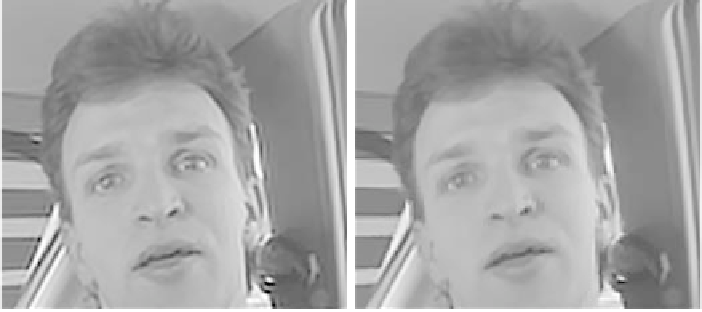Information Technology Reference
In-Depth Information
algorithm closely related to MASK involving iterative 3-D steering kernel regres-
sion; however, it does not require accurate (subpixel) motion estimation. For 3-D
ISKR and MASK, we set the temporal window of support 5, and NL-based SR ap-
proach searches similar local patches across all the frames in time and the window
of support 21
21 in space.
The first example shown in Fig. 11 is a visual comparison of spatial upscaling
and temporal frame interpolation results, using MASK, NL-mean based SR, and 3-
D ISKR. For this example, we used the Car-phone video sequence in QCIF format
(144
×
176 pixels, 30 frames) as input, and spatially upscaled the video with an
upscaling factor of 1 : 3. Fig. 11(a) shows the input frame at time
t
= 25 (upscaled by
pixel-replication). The upscaled results by single frame bicubic interpolation, NL-
mean based SR, 3-D ISKR, and MASK are shown in Figs. 11(b)-(f), respectively. In
addition, Fig. 12 shows a spatiotemporal upscaling example (both spatial upscaling
and temporal frame interpolation) of the Car-phone sequence by 3-D ISKR and
MASK. For this example, we estimated an intermediate frame at time
t
= 25
.
5as
well as spatially upscaling the intermediate frames with the upscaling factor of 1 : 3.
Comparing to the result by bicubic interpolation, all the adaptive methods, NL-
mean based SR, 3-D ISKR, and MASK, reconstruct high-quality upscaled frames,
although each has a few artifacts: jaggy artifacts on edge regions for NL-mean based
SR and MASK, and overshooting artifact for 3-D ISKR.
The second example is spatio-temporal video upscaling using two color real
video sequences: Spin-Calendar (504
×
576
pixels, 30 frames). Fig. 13(a) and 14(a) show an input frame of each sequence at
time
t
= 5, respectively. Spin-Calendar has relatively simple motions, namely ro-
tations. Texas sequence contains more complicated motions, i.e., occlusion, 3-D
rotation of human heads, and reflection on the helmet. Furthermore, Spin-Calendar
×
576 pixels, 30 frames) and Texas (504
×
(a) 3-D ISKR
(b) MASK
Fig. 12
Spatiotemporal upscaling of Car-phone video sequence: (a) upscaled frames by 3-D
iterative SKR [13] at
t
= 25
.
5, and (b) upscaled frames by MASK at
t
= 25
.
5. In this example,
we upscale Car phone sequence shown in Fig. 11(a) with the spatial upscaling factor 1 : 3 and
the temporal upscaling factor 1 : 2.







